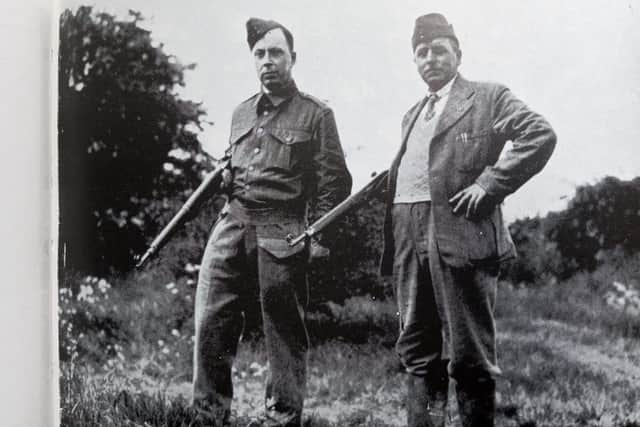Luton History: Home Guards of the Hills
and live on Freeview channel 276
The two proud servicemen in the photo were drawn together by events of War threatening Europe and moving ever closer to our shores.
When War was declared in 1939, the young generation bravely took up Arms to defend our country, however the older ex-servicemen from the encounters of the 1st War ,and those unable to serve, were prepared to help where necessary and do what it takes to protect our Country.
Advertisement
Hide AdAdvertisement
Hide AdIn May 1940, queues formed from Luton Town Hall up to Dunstable Place in Upper George Street volunteering to serve in the newly formed Home Guard (previously known as the LDV). In just one day, 1,000 volunteers had been recruited and the flow continued throughout the War.


The Home Guard's most important job was patrolling the covering Hills around Luton watching for enemy parachute troops, mostly at night in 4-hourly turnabout shifts, but as war progressed, the Home Guard became a National support when and where they were needed.
Reginald John Verran, an ex Navy man (on the left) and Edward Henry Gillingwater (also known as Robert) on the right, were the first armed Home Guard to patrol the areas of Luton.
Reginald Verran born 1899 in Luton, attended Luton Modern School, his father John Verran was the popular Landlord of the "Crown and Anchor " Public House in New Bedford Road for over 50 years.
Advertisement
Hide AdAdvertisement
Hide AdWhen the First World War broke out, "Reggie" signed up in 1916, but was found to be underage and was discharged, however reaching 18 years of age he joined the Volunteer Royal Naval Reserves and later trained as a PO telegraphist.
Seeing hostilities in 1917, he was demobilised in 1918, when he took up farming in Leagrave, he then moved into the Public Licensing sector like his father, until 1940 when he was recruited for the Home Guards.
After the War, he was pulling pints as Landlord of the Regency Arms in Hastings Street and moved onto the George Tap in Waller Street around 1950.
Edward Henry Robert Gillingwater born 1895 in Southwark Surrey, at the age of eighteen was serving in the Surrey Royal Artillery Regiment as a gunner and driver.
Advertisement
Hide AdAdvertisement
Hide AdAt the outbreak of the First World War, he was immediately drafted to the Western Front, he took part in the battle of Ypres, The Somme, Arras and Cambrai.
He won the Military Medal for distinguished Gallantry in the Field, he also held the Mons Star and Victory medal, he was demobilised in 1919 but continued as an Army Reserve for another 2 years.
In 1940, in Uniform again, but just a cap, it was the only piece of uniform they could provide at the time.
Described as an "Old Contemptible", in January 1942 Luton celebrated Warship Week, a fundraising event held to boost the finances towards the War effort.
Advertisement
Hide AdAdvertisement
Hide AdThe event opened with a parade of decorated cars led by Military detachment, The Home Guard and various other organisations.
It was said the most striking feature was provided by "Mr Gillingwater of the Home Guard" dressed as an enemy Officer standing upright in the car gesticulating forwards.
Signposts were attached to the car with Moscow pointing forward and Berlin pointing backwards, however the car being driven in reverse signifying the retreating enemy.
The gesture was welcomed by a tumultuous applause from the crowd.
Edward H. R Gillingwater passed away 1974 in Luton.